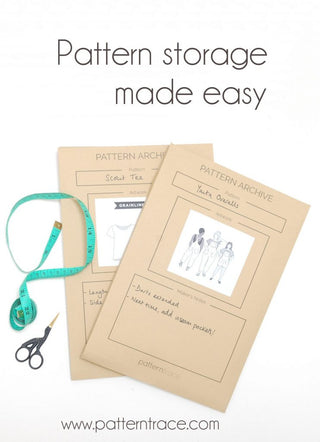I cannot tell you how long I’ve been looking for a simple, stylish way to store my sewing patterns! So I am stoked to bring you our newest product.. The Pattern Archive Envelope.
Study, stylish and with room for you to get creative. No more struggling to get your sewing patterns back into the original envelope.
Best of all is the opportunity to add the pattern artwork to the envelope! A chance for a little creativity!
I’ve always found storing my sewing patterns a bit of a challenge. I tried a few solutions before we developed our storage envelopes, plastic wallets and cardboard envelopes, but nothing quite clicked, they were either messy or impractical. So we are super proud to bring you your very own pattern archive!
The envelopes are strong and sturdy with a side gusset giving the capacity to take a large amount of pattern paperwork. They are perfect for storing your original dressmaking pattern alongside your traced pattern pieces.

Illustrate your storage envelope
Best of all is the opportunity to add the pattern artwork to the envelope to give it even more visual appeal! We’re stoked to be able to add this chance for a little creativity! Our top suggestions for adding a pattern image are:
- Print the instruction booklet cover The easiest option is to print an extra copy of the instruction booklet as they normally have the artwork on the front. If the image is too big you could copy it into word and resize it before you print it.
- Photocopy the pattern envelope Again, you might have have to fiddle with the scale on the photocopier to get the image the right size.
- Draw your own! Whether it’s your own self drafted pattern or a hack of an existing pattern, why not draw your own artwork? From a simple pencil sketch to a full blown collage
- Print a photo of the garment you made. This will serve as a great reminder of how your first one turned out, and give you inspiration for future versions.

Storing your envelopes
Our top tip for extra level organisation is to use some washi tape on the top edge to colour code the type of pattern inside, how about coding them according to
- Garment type
- Who the pattern is for
- Your tried & tested favourites

The envelopes come with a peel and seal closure, but since we’re going to be using it over and over again we’ve chosen to seal ours with washi tape.

